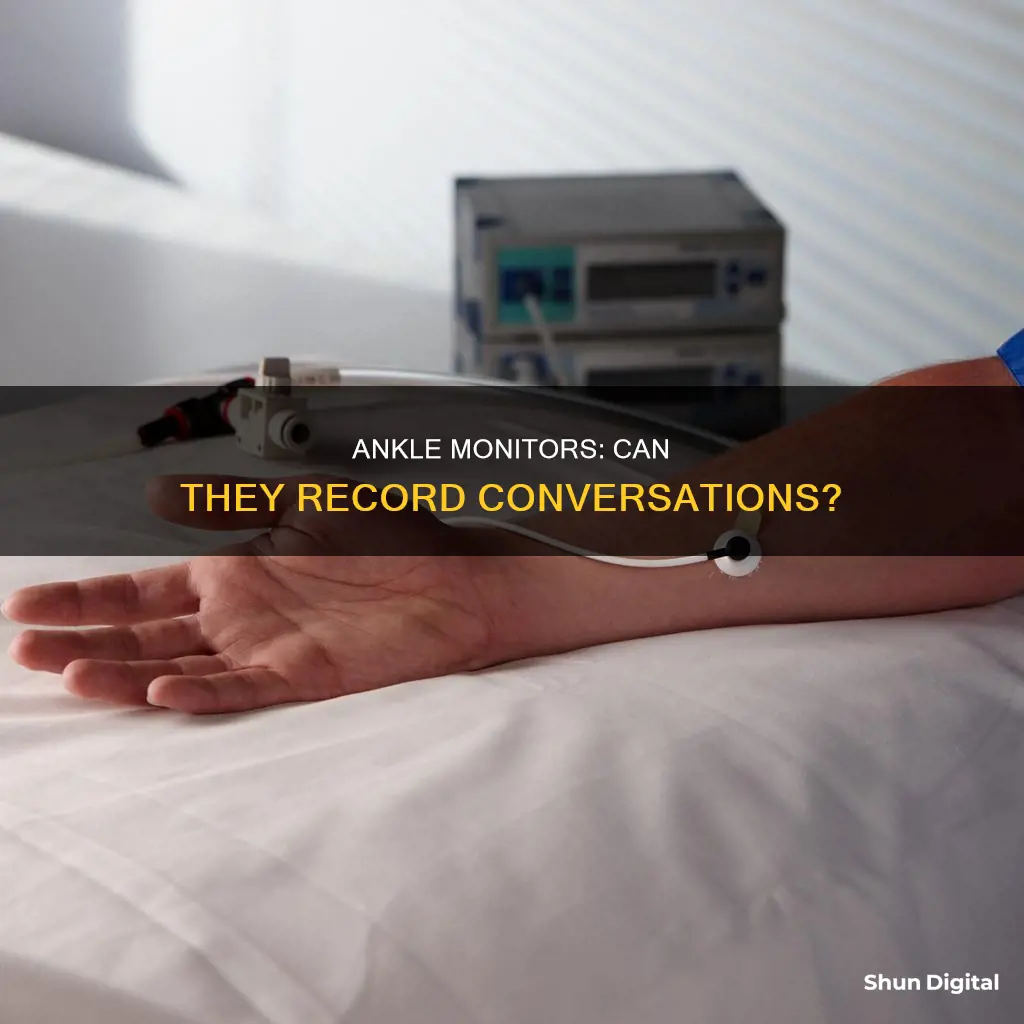
SCRAM ankle monitors are electronic devices used to monitor the alcohol consumption of individuals. They are typically worn by DUI offenders, who are legally required to avoid alcohol consumption as a penalty for their offence. SCRAM stands for Secure Continuous Remote Alcohol Monitor. These devices are also known as Continuous Alcohol Monitoring (CAM) bracelets. They test the wearer's sweat every thirty minutes for the presence of alcohol. While SCRAM ankle monitors do not record conversations, some other types of ankle monitors have been known to do so without notifying the wearer.
| Characteristics | Values |
|---|---|
| Purpose | Monitor alcohol consumption |
| Type of data recorded | Alcohol consumption, sweat patterns |
| Data storage | 90 days |
| Alert mechanism | Alert sent to database if alcohol is consumed |
| Alert response | Analyst investigates further and notifies probation officer if necessary |
| Installation fee | $50 to $100 |
| Daily monitoring fee | $10 to $15 |
| Monthly cost | Up to $300 |
| Removal consequences | Alert sent to regional monitoring center, leading to harsh sentencing or longer probation |
| Monitoring technology | GPS, RF/Radio Frequency |
| Microphone | No |
| Recording conversations | No |
What You'll Learn
- SCRAM ankle monitors do not record conversations
- SCRAM is an acronym for Secure Continuous Remote Alcohol Monitor
- SCRAM ankle monitors are used to detect alcohol consumption
- SCRAM ankle monitors can be used as an alternative to incarceration
- SCRAM ankle monitors can be used as a condition for parole or probation

SCRAM ankle monitors do not record conversations
SCRAM stands for "Secure Continuous Remote Alcohol Monitor". These ankle monitors are court-ordered for DUI offenders, especially those who are second- or third-time offenders, to ensure they do not consume alcohol. They are also used as a pretrial condition of probation or for those on parole.
While SCRAM ankle monitors do not record conversations, they do have other features to ensure compliance. They are equipped with anti-tamper technology, which means that any attempts to destroy or remove the device will be detected and will result in an immediate alert to the regional monitoring centre. They also have long-lasting batteries, with up to 40 hours of power, to reduce low-power alerts.
Some other types of ankle monitors do have microphones and the ability to record conversations. However, this is not a feature of SCRAM ankle monitors, whose primary function is the monitoring of alcohol consumption.
Heart Rate Monitor: What You Need to Know
You may want to see also

SCRAM is an acronym for Secure Continuous Remote Alcohol Monitor
The SCRAM CAM bracelet provides 24/7 transdermal alcohol testing by sampling the wearer's perspiration every 30 minutes. This skin-level measurement is known as "transdermal" alcohol concentration. The monitor will test the wearer's sweat even when they are sleeping, at work, out with friends, or not profusely sweating. The data is then sent to a central monitoring system that receives the data wirelessly. This allows for the continuous remote monitoring of the individual's alcohol consumption.
In addition to alcohol monitoring, SCRAM ankle monitors can also provide location tracking. The SCRAM GPS® combines location accuracy, strap design, long battery life, and user-friendly software tools that help officers identify and address issues. The GPS functionality helps officers supervise clients while enhancing community safety.
The SCRAM ankle monitor is a useful tool for ensuring compliance with court-ordered restrictions and promoting behaviour change. It encourages accountability and supports sobriety by providing accurate data on alcohol consumption.
TFT vs LCD: Understanding Monitor Technology
You may want to see also

SCRAM ankle monitors are used to detect alcohol consumption
SCRAM ankle monitors, otherwise known as Continuous Alcohol Monitoring (CAM) bracelets, are used to detect alcohol consumption. They are often worn by DUI offenders, who are required to wear one to monitor their blood alcohol concentration. The monitor tests the wearer's perspiration or sweat every thirty minutes, twenty-four hours a day, to detect the presence of alcohol. This is known as transdermal alcohol testing or transdermal alcohol concentration.
The SCRAM CAM bracelet provides 24/7 alcohol testing for hardcore drunk drivers, high-risk alcohol and domestic violence cases. It is a way to ensure sobriety and increase compliance with court orders. The bracelet is fitted to the individual's ankle and is typically worn for 30, 60 or 90 days. The readings are transmitted wirelessly to a Base Station twice a day, or when the individual returns to the Base Station if they have been out of range.
The SCRAM ankle monitor is an innovative way to carry out continuous alcohol monitoring, profiling a day-by-day pattern of alcohol use by a person. The monitor can detect low alcohol consumption (1-2 units) and can be used to ascertain a detailed pattern of alcohol consumption over a specific period, which can then be used in a legal setting.
The SCRAM ankle monitor is a useful tool for those who are attempting to change their behaviour and achieve long-term sobriety.
Easy Guide: Connecting Your Monitor to TW
You may want to see also

SCRAM ankle monitors can be used as an alternative to incarceration
SCRAM ankle monitors are increasingly viewed as a more humane alternative to incarceration. They are often used for high-risk clients requiring constant location monitoring, such as sex and violent offenders, and those with domestic violence caseloads. SCRAM GPS offers revolutionary tamper technology that virtually eliminates false alerts and provides nearly instant notifications to officers. This enables officers to act quickly and address issues efficiently.
The GPS technology in SCRAM ankle monitors helps officers supervise clients more effectively while enhancing community safety. It provides superior location accuracy, long battery life, and user-friendly software tools. With Google Maps and Google Info windows built into the SCRAM GPS monitoring software, officers can easily identify a client's exact location and understand their movements. This technology can also be used to notify victims and supervising authorities when a client is in proximity to the victim's phone, providing added peace of mind.
SCRAM ankle monitors are particularly useful for monitoring alcohol consumption in DUI offenders. The monitors test the wearer's sweat every 30 minutes for the presence of alcohol, providing a "transdermal" alcohol concentration reading. This helps ensure compliance with court-ordered sobriety and encourages long-term behaviour change.
However, it is important to note that some concerns have been raised about the use of SCRAM ankle monitors as an alternative to incarceration. A report by Kate Weisburd, an associate professor of law at George Washington University, highlights how electronic monitoring can deprive individuals of fundamental rights, violate privacy, impact employment, and undermine family and social relationships. The report also found that people ordered to wear electronic monitors often face restrictive rules and may be set up for failure and reincarceration due to technical violations.
Asus Monitor Brightness: Optimal Settings for Eye Comfort
You may want to see also

SCRAM ankle monitors can be used as a condition for parole or probation
SCRAM (Secure Continuous Remote Alcohol Monitor) ankle monitors are often used as a condition for parole or probation. They are typically court-ordered for DUI offenders, especially those who are second- or third-time offenders, to ensure they avoid alcohol consumption. The ankle monitor acts as a deterrent and will alert the probation officer if alcohol is consumed, leading to potential consequences like jail time, fines, or prolonged probation.
The SCRAM ankle monitor is an alcohol detector in the form of a bracelet that tests the wearer's sweat every thirty minutes, twenty-four hours a day, for the presence of alcohol. This skin-level measurement is known as "transdermal" alcohol concentration and is an effective way to monitor blood alcohol concentration. The device is tamper-proof, sending immediate alerts to the monitoring center if any attempts are made to remove or destroy it.
In addition to monitoring alcohol consumption, SCRAM ankle monitors can also incorporate GPS technology. This allows authorities to track the wearer's location, making it a useful tool for parole or probation officers to supervise high-risk individuals. The GPS feature enhances community safety and provides an alternative to incarceration, allowing individuals to reintegrate into society while being monitored.
While SCRAM ankle monitors are commonly used as a condition for parole or probation, they can also be implemented as a pretrial condition for release from jail. This means that individuals awaiting trial may be required to wear the monitor, in addition to other restrictions on their movements and activities.
The use of SCRAM ankle monitors as a condition for parole or probation has been adopted in various jurisdictions, including the United States, England, Wales, Australia, and New Zealand. The effectiveness of these monitors in reducing reoffending rates and ensuring compliance with court-ordered conditions has been the subject of studies and debates.
Exploring the ASUS Monitor PG: Button Functionality Explained
You may want to see also
Frequently asked questions
No, SCRAM ankle monitors do not record conversations. They are designed to monitor alcohol consumption through perspiration.
SCRAM stands for Secure Continuous Remote Alcohol Monitor. It is a type of ankle monitor that monitors the wearer's alcohol consumption through continuous transdermal alcohol testing.
The SCRAM ankle monitor tests the wearer's sweat every 30 minutes, 24 hours a day, for the presence of alcohol. This skin-level measurement is known as transdermal alcohol concentration.
Removing a SCRAM ankle monitor is a violation of the law and can result in legal consequences. If the monitor is cut or damaged, it will notify law enforcement and trigger a response.







